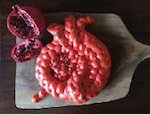
Baking Challah to Bring the Torah
As my mother drove a car full of kids to elementary school, I sat in the backseat, creating dough. The blue mixing bowl on my lap didn’t protect my clothes and the vehicle from a light layer of flour, and the practice was probably not the most sanitary, but the Friday was busy, and 7:30am was the only time for dough prep.
Challah, a staple of Shabbat, holiday tradition and Jewish cuisine, plays many roles: a rushed ritual in the back of a moving vehicle; the perfect bookends for a deli meat sandwich; a piece tossed across the family table; the loaf the dog can’t seem to get enough of. For Vanessa Harper, challah has become a space for shaping and sharing Torah.
Harper, a third year dual rabbinical and education program student at Hebrew Union College, uses the medium of challah as “a medium of interpretation.” Last year, she followed the entire Torah cycle, shaping and baking a challah in relation to each portion.
“There’s something a little wonderfully subversive about how bread-making has been the province of women for so long. For so many centuries, women’s contribution to the Shabbat table has been the food and the challahs, and men bring the dvar torah. And so using the challah to bring the Torah is in a way, a feminist, subversive act,” Harper told Lilith over a challah-making tutorial. With Lilith, Harper created a pomegranate shaped challah. The pomegranate corresponded to the High Priest’s robe, described in the Torah portion Tetzaveh as adorned with bells and pomegranates.


